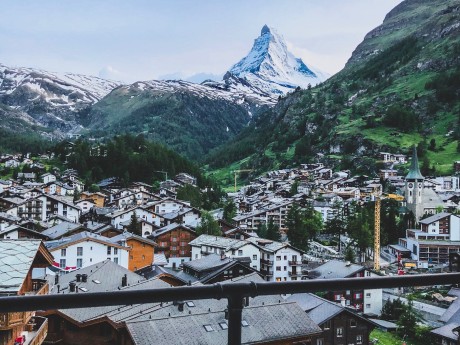Winter Wonderland Switzerland: Zurich, Bern & Zermatt
Discover ancient architecture, indulge in delicious meals and marvel at breathtaking sites on your Switzerland journey. Start your journey in Zurich, the largest city in Switzerland. Art enthusiasts will enjoy the outstanding museums such as Kunsthaus Zurich while shopaholics will find paradise at Bahnhofstrasse. For those more intuned with nature, take a boat cruise tour or visit Switzerland's many lakes and waterfalls, such as Rhine Falls. Your journey continues to Bern.
Read more
Discover ancient architecture, indulge in delicious meals and marvel at breathtaking sites on your Switzerland journey. Start your journey in Zurich, the largest city in Switzerland. Art enthusiasts will enjoy the outstanding museums such as Kunsthaus Zurich while shopaholics will find paradise at Bahnhofstrasse. For those more intuned with nature, take a boat cruise tour or visit Switzerland's many lakes and waterfalls, such as Rhine Falls. Your journey continues to Bern. Surrounded by the Aare River, Bern is known for its mediaeval architecture well-preserved in the Altstadt. With many historical places to visit, such as the Neo-Renaissance Bundeshaus or the Französische Kirche, the city is a must stop for travellers crossing through Switzerland. Finally, your journey ends in southern Switzerland’s Valais canton, Zermatt. At an elevation of 1,600 m, this town is the ideal destination for mountain climbers, hikers, and skiers. See breathtaking views of the iconic Matterhorn Mountain or stroll along the main river, the Matter Vispa. Waterviews strives to offer accommodation options within walking distance of water and/or in an area of touristic interest. Our prices include taxes (but excludes local tourist taxes). Customize your trip to your personal preferences with optional activities (hit the “Add Activities’’) or change hotels, etc. Contact us for customization at no extra cost at: Service@waterviewstravel.com
Destinations
- Zurich
- Berne
- Zermatt
- Zurich
Itinerary
Zurich
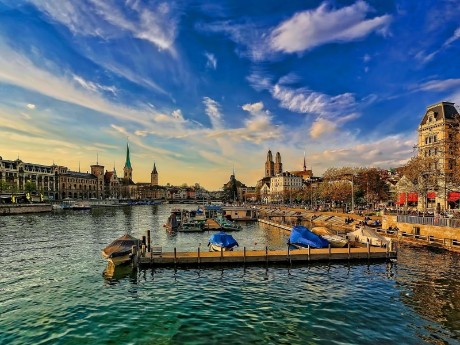
Although known worldwide as a centre for banking and finance, Switzerland’s largest city has a lot more to offer; its picturesque setting between a lake and a river with the glorious peaks of the Alps in the distance is instantly mesmerising, and the winding cobbled lanes of the old town are filled with intact medieval churches, squares and quaint cafes. Yet despite its rich history, Zürich has a contemporary, vibrant and post-industrial feel and has become a European hub for art, culture and innovation.
Read more
Although known worldwide as a centre for banking and finance, Switzerland’s largest city has a lot more to offer; its picturesque setting between a lake and a river with the glorious peaks of the Alps in the distance is instantly mesmerising, and the winding cobbled lanes of the old town are filled with intact medieval churches, squares and quaint cafes. Yet despite its rich history, Zürich has a contemporary, vibrant and post-industrial feel and has become a European hub for art, culture and innovation.
Additional Information
Zurich is Switzerland's biggest city and a cultural center of German-speaking Switzerland. Despite it not being the administrative capital of any more than its Kanton, Zurich punches well above its weight in terms of major media and business headquarters and due to it being at the heart of Switzerland's excessively punctual and meticulously maintained train network and being home to Switzerland's most important airport, it is often the first part of Switzerland that visitors get to see. Zurich is close to some excellent skiing resorts and many people headed for the Swiss Alps don't spend much time in Zurich itself, but you'd be missing a lot if you don't stay in Zurich for a couple of days at least.
While Zurich can be expensive, it is also clean, efficient and blessed with a high standard of living, which together with the high wages, explains why people bear with the high prices. Zurich has drawn people from the rest of Switzerland for centuries, but in the 20th and 21st century it has also begun to draw both people and companies from outside Switzerland and in some cases even outside Europe. This means that you will hear a lot more languages than just Swiss German and the overall atmosphere is a lot more cosmopolitan than you might think.
Zurich is home to ETH Zurich, one of the world's leading technical universities, which has produced a number of Nobel laureates and numerous innovations and due to Switzerland's long history of neutrality it also houses headquarters of the likes of FIFA or the International Ice Hockey Federation. Zurich is also home to a number of large banking and insurance conglomerates that grew on the fabled Swiss banking secret and still enjoy good reputations in the financial sector.
History
The city's Latin name, Turicum, was used for a Roman customs station at the Limmat, which has some remnants today. The Alemanni, a Germanic tribe, settled in the 5th century.
While the Church used to rule early Medieval Zurich, the Guilds (Zünfte) took power in 1336, establishing Zurich as an autonomous republic. The Guilds have survived until today, though their role today is mostly ceremonial. Zurich became the fifth canton of the Swiss Confederacy in 1351, and has been its capital at times. However, Switzerland's famous neutrality and stability is a modern thing, as many battles have been fought in and around Zurich. The canton lost the Old Zürich War between 1440 and 1446 against the confederacy, and was re-admitted in 1450.
Ulrich Zwingli led the Protestant Reformation in Switzerland during the early 16th century. As the Thirty Years War ended in 1648, the Holy Roman Empire lost its grip on Switzerland, which has mostly been independent since then.
The 1830s and 40s saw a series of revolts and war, including the Züriputsch, a revolt of conservative landowners of the canton, against the city of Zurich, and the 1847 Sonderbund War. In 1848 Switzerland adopted a constitution, which established the country as a federal republic. While the government settled in Bern, many federal institutions, including the new Polytechnic University (ETH) have their seat in Zurich.
The Zurich Stock Exchange was founded in 1877, and the city rose as a financial centre in the 20th century, as Switzerland remained neutral in the World Wars, and could maintain lower taxes on capital than the European great powers. Even though Switzerland has opted out of NATO and the European Union, Zurich is today one of central Europe's most cosmopolitan cities.
Climate
Zurich has a four-season climate typical to central Europe. Temperature in winter is usually around zero degrees, which means that snow can linger or melt away. Summers are warm with temperature in the 20s and occasionally in the 30s. The nearby mountains are significantly colder than in the valley, with snow remaining well into spring.
© Sourced from Wikivoyage
Berne
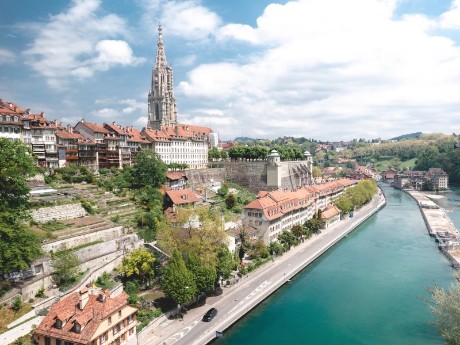
Although small in size, Switzerland’s de facto capital city is bursting with charm; its stunning location on a peninsula on the River Aare with the snow-capped Alps glistening in the distance give visitors a first impression that doesn’t disappoint. The cobbled streets of the preserved old town are lined with medieval arcades holding shops, cafes and restaurants - the incredible architecture even earned the city UNESCO World Heritage status - and ancient clock towers and cathedrals blend perfectly into the scenic cityscape.
Read more
Although small in size, Switzerland’s de facto capital city is bursting with charm; its stunning location on a peninsula on the River Aare with the snow-capped Alps glistening in the distance give visitors a first impression that doesn’t disappoint. The cobbled streets of the preserved old town are lined with medieval arcades holding shops, cafes and restaurants - the incredible architecture even earned the city UNESCO World Heritage status - and ancient clock towers and cathedrals blend perfectly into the scenic cityscape.
Additional Information
Berne was founded in 1191 by Duke Berthold V von Zähringen and was part of the Holy Roman Empire. It was made a free imperial city by the Holy Roman Emperor Frederick II in 1218 after Berthold died without an heir.
In 1353 Berne joined the Swiss confederation. After conquering several rivals, Berne became the largest independent city state north of the Alps. It was occupied by French troops in 1798 during the French Revolutionary Wars, and was stripped of a large part of its territory. The city became the Swiss capital in 1848.
Bern was one of the eight host cities in the 2008 European Football Championships.
© Sourced from Wikivoyage
Zermatt
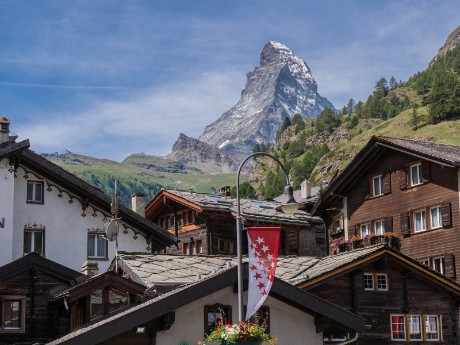
The tall, snow-covered peak of the Matterhorn mountain rises above traditional wooden chalets in Zermatt, one of Switzerland’s most iconic ski resorts. The town has been a popular destination since the 19th century, and boasts a mixed year-round crowd of skiers, climbers, backpackers and socialites who come to experience the breathtaking magic of the Swiss mountains. Sophisticated bars and luxury lodges contrast with budget hostels, and despite being renowned for its high prices Zermatt has offerings for every budget and taste.
Read more
The tall, snow-covered peak of the Matterhorn mountain rises above traditional wooden chalets in Zermatt, one of Switzerland’s most iconic ski resorts. The town has been a popular destination since the 19th century, and boasts a mixed year-round crowd of skiers, climbers, backpackers and socialites who come to experience the breathtaking magic of the Swiss mountains. Sophisticated bars and luxury lodges contrast with budget hostels, and despite being renowned for its high prices Zermatt has offerings for every budget and taste.
Additional Information
Zermatt is surrounded by a range of fabulous mountains, including the highest of Switzerland, Monte Rosa. However the most famous of them is Matterhorn. It was one of the last alpine mountains to be conquered (in 1865), and the first expedition that reached the top ended dramatically (only 3 of the 7 climbers survived).
If you've never experienced a car-free city of any size then Zermatt could be a bit of a surprise: during the high season nearly there are 20,000 people living in a town with only 5 or 6 streets and more significantly almost no internal combustion vehicles except very occasional outside delivery and specialist services. This means that you can leave a noisy bar or party, and a few minutes later on foot find yourself in utter tranquillity. You can sit on the hotel balcony and listen to dozens of varieties of songbirds while watching the sun set on one of the most striking mountains in the western world. Wake up with the sun in a four or five-star room or a canvas tent to the sound of the aforementioned birds, crickets, church bells, and children's laughter.
Almost all vehicles in Zermatt are battery driven and almost completely silent. Taxi drivers have a habit of assuming that pedestrians have eyes in the backs of their heads, with occasional alarming though seldom injurious consequences. Horse-drawn vehicles are equipped with bells and many startled pedestrians might well wish taxis were similarly provided.
You can cycle or stroll in complete safety.
Incidentally there is a version of the standard Zermatt ski map/summer walking map in English although for some reason the lift stations only seem to hand out the German/French versions with tickets. The map is free - you can generally find it on one of the stands in the lift stations or in the Tourist Information centre.
The name "Zermatt" is a contraction of the local dialect words "zer", which means "to", and "matta", which means "field" or "meadow". Therefore: "to the field", although many of the fields have since had hotels of apartment houses built on them.
© Sourced from Wikivoyage
Zurich
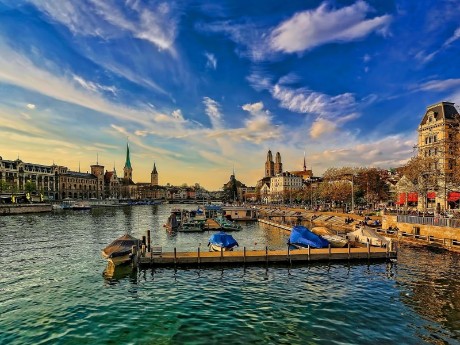
Although known worldwide as a centre for banking and finance, Switzerland’s largest city has a lot more to offer; its picturesque setting between a lake and a river with the glorious peaks of the Alps in the distance is instantly mesmerising, and the winding cobbled lanes of the old town are filled with intact medieval churches, squares and quaint cafes. Yet despite its rich history, Zürich has a contemporary, vibrant and post-industrial feel and has become a European hub for art, culture and innovation.
Read more
Although known worldwide as a centre for banking and finance, Switzerland’s largest city has a lot more to offer; its picturesque setting between a lake and a river with the glorious peaks of the Alps in the distance is instantly mesmerising, and the winding cobbled lanes of the old town are filled with intact medieval churches, squares and quaint cafes. Yet despite its rich history, Zürich has a contemporary, vibrant and post-industrial feel and has become a European hub for art, culture and innovation.
Additional Information
Zurich is Switzerland's biggest city and a cultural center of German-speaking Switzerland. Despite it not being the administrative capital of any more than its Kanton, Zurich punches well above its weight in terms of major media and business headquarters and due to it being at the heart of Switzerland's excessively punctual and meticulously maintained train network and being home to Switzerland's most important airport, it is often the first part of Switzerland that visitors get to see. Zurich is close to some excellent skiing resorts and many people headed for the Swiss Alps don't spend much time in Zurich itself, but you'd be missing a lot if you don't stay in Zurich for a couple of days at least.
While Zurich can be expensive, it is also clean, efficient and blessed with a high standard of living, which together with the high wages, explains why people bear with the high prices. Zurich has drawn people from the rest of Switzerland for centuries, but in the 20th and 21st century it has also begun to draw both people and companies from outside Switzerland and in some cases even outside Europe. This means that you will hear a lot more languages than just Swiss German and the overall atmosphere is a lot more cosmopolitan than you might think.
Zurich is home to ETH Zurich, one of the world's leading technical universities, which has produced a number of Nobel laureates and numerous innovations and due to Switzerland's long history of neutrality it also houses headquarters of the likes of FIFA or the International Ice Hockey Federation. Zurich is also home to a number of large banking and insurance conglomerates that grew on the fabled Swiss banking secret and still enjoy good reputations in the financial sector.
History
The city's Latin name, Turicum, was used for a Roman customs station at the Limmat, which has some remnants today. The Alemanni, a Germanic tribe, settled in the 5th century.
While the Church used to rule early Medieval Zurich, the Guilds (Zünfte) took power in 1336, establishing Zurich as an autonomous republic. The Guilds have survived until today, though their role today is mostly ceremonial. Zurich became the fifth canton of the Swiss Confederacy in 1351, and has been its capital at times. However, Switzerland's famous neutrality and stability is a modern thing, as many battles have been fought in and around Zurich. The canton lost the Old Zürich War between 1440 and 1446 against the confederacy, and was re-admitted in 1450.
Ulrich Zwingli led the Protestant Reformation in Switzerland during the early 16th century. As the Thirty Years War ended in 1648, the Holy Roman Empire lost its grip on Switzerland, which has mostly been independent since then.
The 1830s and 40s saw a series of revolts and war, including the Züriputsch, a revolt of conservative landowners of the canton, against the city of Zurich, and the 1847 Sonderbund War. In 1848 Switzerland adopted a constitution, which established the country as a federal republic. While the government settled in Bern, many federal institutions, including the new Polytechnic University (ETH) have their seat in Zurich.
The Zurich Stock Exchange was founded in 1877, and the city rose as a financial centre in the 20th century, as Switzerland remained neutral in the World Wars, and could maintain lower taxes on capital than the European great powers. Even though Switzerland has opted out of NATO and the European Union, Zurich is today one of central Europe's most cosmopolitan cities.
Climate
Zurich has a four-season climate typical to central Europe. Temperature in winter is usually around zero degrees, which means that snow can linger or melt away. Summers are warm with temperature in the 20s and occasionally in the 30s. The nearby mountains are significantly colder than in the valley, with snow remaining well into spring.
© Sourced from Wikivoyage




